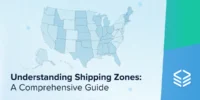Due to the Coronavirus epidemic, Amazon recently announced that it will be suspending shipments of all nonessential products to its warehouses and prioritizing medical supplies, household staples and other high-demand products to its warehouses until April 5. That’s good news for the medical professionals who desperately need those products but bad news for sellers who can no longer ship nonessential products to Amazon. Fortunately, it’s easy to go from FBA (Fulfillment By Amazon) to FBM (Fulfillment By Merchant) with Flowspace.
Amazon Suspends All Nonessential Shipments To Warehouses
In response to the steep demand for household staples, medical supplies, and other high-demand products Amazon recently announced that it will block shipments of “nonessential products” to its fulfillment centers. Nonessential products include everything that does not fall into one of six categories:
- Baby Products
- Health and Household Appliances
- Beauty and Personal Care
- Grocery
- Industrial and Scientific
- Pet Supplies.
That means sellers who rely on Fulfillment By Amazon (FBA) — and which account for nearly 60% of all goods sold on its site — are prohibited from shipping their goods to Amazon for fulfillment, storage, and delivery.
Merchants can still sell their products on the Amazon platform for a fixed fee but Amazon is not responsible for storage, fulfillment, or shipping of those products. These restrictions also apply to wholesale vendors who ship their products to Amazon and resell at a markup.
How Will The Coronavirus Affect Fulfillment By Amazon Sellers?
Though some of the measures taken by Amazon were to be expected, many retailers see the retail-giant’s recent announcement as a death-blow to their business. Merchants writing on Amazon’s message board for third-party sellers characterized the panic consuming the community,
“Amazon just put tons of businesses out of business… Most of us do not have the infrastructure in place. We do not have the boxes or packing material to do this.” Amazon tried to reassure the FBA community by writing on their forum,
“We understand this is a change to your business, and we did not take this decision lightly,” adding, “We appreciate your understanding as we prioritize the above products for our customers.”
The statement did little to assuage merchants who sell more discretionary goods, which account for 58% of all goods sold on the Amazon platform. Nor did it assure wholesalers who planned to ship to Amazon warehouses in near future.
To help calm some of the anxiety gripping the Online Merchant Community – to which Flowspace is a proud member – we have compiled the following report on what may affect FBA sellers in the coming months.
Supply Chain Disruption
The Coronavirus epidemic has ravaged the global supply chain. Companies most affected are those that rely heavily or solely on parts and materials sourced from factories in China where manufacturing plant activity has fallen well below normal levels.
Herein lies the problem. As the virus spreads and millions of consumers are forced to work from home or shelter in place, the demand for e-commerce and online retail will increase exponentially.
As COVID-19 makes it harder for manufacturers to get raw materials to their facilities from Europe and Asia, merchants and wholesalers in the United States are finding it difficult to get their products to their customers at home across the country.
Product Triage and Prioritization
Amazon is far from the only retail giant to feel the affects of the COVID-19 epidemic. Everyone from UPS and FedEx to Walmart and Target are overwhelmed by the Coronavirus disruption. A note on Target’s website said they are,
“Working hard to accommodate this increased demand… coordinating stores, distribution centers and suppliers so that the things our guests need most – cleaning supplies, food, over-the-counter medicine and baby products—are fast-tracked through the supply chain and prioritized for re-stocking.”
As the virus spreads, we can expect more and more online retailers and last mile delivery providers to prioritize essential items, leaving third-party merchants to store, fulfill and ship products on their own.
Product Inventory Shortages
Prior to the Coronavirus outbreak, most merchants maintained three to six months of available inventory based on prevailing forecasts. Unfortunately, experts project that the epidemic will last far longer than that.
Thus, we are yet to feel the true impact of the manufacturing suspensions and supply chain disruptions, as we are yet to run out of that available inventory. However, that is sure to change in Q3 and Q4 when replenishments are expected and not delivered.
Desperate Need For Proven Inventory Control Capabilities
With manufacturing and inventory concerns at the forefront of our collective thoughts, merchants in the best position to survive the current upheaval will be those with proven inventory control capabilities and the ability to preemptively store, fulfill, and ship excess inventory.
Merchants with multiple distribution center touchpoints will be better able to react to shifts in demand – as with the COVID-19 outbreak – and continue last-mile delivery service to their customers when shippers are forced to prioritize essential goods.
Now’s the Time to Switch from FBA to FBM with Flowspace
Like it or not, sales made on the Amazon platform account for nearly 40% of all retail sales in the United states. But, if recent events have proven anything, it’s that we as consumers, merchants, and wholesalers rely too much on Amazon for storage, fulfillment, and delivery.
Now that the coronavirus outbreak has pushed the retail-giant to its maximum capacity, many of us are discovering that our livelihoods were not as secure as we thought they were. Fortunately, there is hope for those merchants deemed “nonessential”.
By switching from Fulfillment by Amazon (FBA) to Fulfillment by Merchant (FBM) with Flowspace, you can deploy different inventory volumes to different warehouses across the country; adjust your distribution network to variable demand and minimize the affects of the next outbreak on your supply chain.
We’ll show you how in “Part Two of How to go from FBA to FBM with Flowspace”. Or you can request more information by clicking below.





